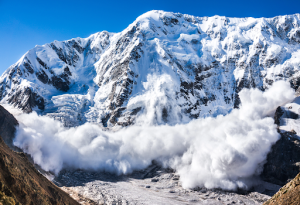11 Oct Avalanches: A Himalayan disaster
Avalanches- A Himalayan disaster
The topic is based on Avalanches- A Himalayan disaster. The article tells you how this disaster impacts Biodiversity and Climate Change.

Pic: Avalanches- A Himalayan disaster
Prelims: General issues on Environmental ecology, Bio-diversity, and Climate Change – that do not require subject specialization.
Mains: General Studies III: Disaster and disaster management.
Why in headlines?
Recently 12 dead bodies were recovered from the site of an avalanche that hit a team of Climbers in Uttarkashi in the Uttarakhand district,
Avalanches are
- These are masses of snow, ice, and rocks that fall expeditiously down a mountainside.
There are mainly three types of Avalanches
Slab avalanches
- A slab avalanche takes place when the weak layer lies lower down in a snowpack.
- The weaker layer is covered with other layers of compressed snow.
- When the avalanche is triggered, the weak layer breaks off, pulling all the layers on top of it down the slope. These layers tumble and fall in a giant block, or slab.
Loose snow avalanches
- Loose snow avalanches take place when under the ‘weight when poorly bonded surface snow slides downhill.
- They usually occur on steep slopes and are seen after a fresh snowfall.
Cornices
- These are overhanding masses of wind–deposited snow projected from sharp terrain features like ridges or peaks.
- They can be as beautiful and as deadly, breaking off in response to changing weather or the weight of a person or machine
Powder Snow Avalanches
- It is a mixture of all other types of Avalanches, like Loose Snow and Slab.
- The bottom half of power snow avalanches is made of a slab or a dense concentration of snow, ice, and air.
The main causes of Avalanches
Heavy rainfall
- Heavy rain rainfall is the primary cause of avalanches because it deposits the snow in unbalanced areas and it puts pressure on the snow back
- Raining during the summer also leads to a cause of wet snow avalanches
Natural Causes
- the natural courses like earthquakes and tremors also trigger avalanches as they sometimes create cracks in the snowpack
- the fresh snow or rain can cause built-up snow to loosen and fall down in the snowpacks
Human Activity
- In recent years human activities have triggered many avalanches
- Heavy deforestation and soil erosion in mountains, result into very less stability of snow during winter seasons
- Winter sports that require steep slopes often put pressure on the snowpack, which it cannot deal with.
- Sometimes the weak layers of the snow cannot withstand the vibrations within the snow created by the Terrain vehicles,
Steep Slopes
- Layers of snow build-up and slide down the mountain at a faster rate as steep slopes can increase the speed of snow.
- A rock or piece of huge ice can shake the snow and cause it to come down.
Winter Sports Activities
- Above all factors, this factor will act like the last nail to trigger steep slopes or loose snowpacks by skiers or other winter sports activities.
Effects of Avalanches
Damage to Life and Property
- A huge number of casualties take place when avalanches hit a largely populated area
- The roadways blockages caused due to avalanches impact the livelihoods of local peoples
- The infrastructure is damaged, as strong avalanches can destroy buildings
- Infrastructure is damaged, and the blockage caused impacts the livelihood of many.
Flash floods
- All the debris came along with the avalanches when it takes place and can cause calamity in low-lying areas.
In general, flash floods are seen to happen after avalanches,
Property and Transportation
- A huge amount of snow can cover entire mountain passes and travel routes with cars and trains traveling on these routes.
Utilities and Communication
- strong snow waves have the capability to completely destroy pipelines carrying gas or oil, thus causing leaks and spillage.
- Broken power lines can cause a disruption in electricity and cause thousands of people to go without power.
- Communication fields, such as telephone and cable lines, could go silent, causing panic and a delay in response time and rescue.
Why the Himalayas are vulnerable to Avalanches?
- The climatic condition is fragile snow-covered Himalayas has been changing very fast
- Experts stated that it has been found that winter temperatures in the northwestern Himalayas have risen on an average 0.65-degree celsius over a period of 25 years from 1991 — greater than the global average rise of 0.44 degrees Celsius.
- At this time, total winter precipitation has increased with greater rainfall and lesser snowfall.
- Increasing temperatures have driven an increase in the frequency of avalanches since 1970, creating a threat to the road that provides access to the newly built Rohtang tunnel.
What are the Prediction and protective measures for Avalanches in India
In order to reduce causalities and to provide protection to villages and roads, the government attempts to predict and prevent avalanches
Avalanche Prevention Structure

Snow Drift Prevention Structure

Snow Removal & Melting Structures

Also, read
Sources:
Daily Current Affairs for UPSC
For gaining General Knowledge, Current Affairs plays a very important role for this. Without reading current affairs, you will not pass any competitive examination. So it is very important for any IAS aspirant to read current affairs daily. Get the latest Current Affairs for the UPSC examination from Plutus IAS free of cost. It will help you to pass the mains, prelims, and interview exams.



No Comments